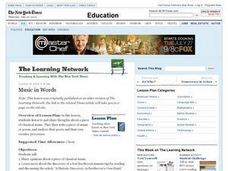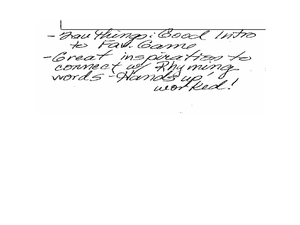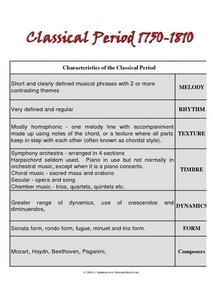Curated OER
Look in the Mythic Mirror: I've Got Rhythm!
Learners explore the relationships between music, poetry, and visual art. Using the story of Orpheus and Eurydice, pupils develop an awareness of the compositional elements of the Classical style, and the aesthetic effects of those...
Curated OER
Music in Words
Your class can build strong, well-represented opinions about the music they hear. They listen to, and share thoughts about, a piece of classical music. Then they write a piece of music or a poem, and analyze their peers' work and their...
Curated OER
Creating an Original Opera
This may be a lot to ask of a high schooler, but then again, who knows? Pupils work in groups to explore, write, and then perform an original opera. They view versions of The Magic Flute and La Traviata, then compose a plot, characters,...
Curated OER
GCSE Notes 2000: Classical Music
Classical period music is defined by its characteristics and distinctive sound. A set of notes assists upper graders in recalling and analyzing music from the classical period based on musical terminology. An example analysis of Eine...
Curated OER
Peter and the Wolf
Peter and the Wolf is a wonderful piece that introduces learners to classical music, builds listening skills, and creates a bridge from song to imagination. Each slide shows a picture of one of the characters from the story and a group...
Curated OER
The Sorcerer's Apprentice: 200 Greatest Pop Culture Icons
Upper graders view the animated short, "The Sorcerer's Apprentice" and analyze how the music score was chosen to express the scene. They create an animation as they listen to a classical recording to experience the connection between...
Curated OER
Ballet and Classical Music
Fourth graders explore ballet. In this dance and music humanities lesson, 4th graders practice ballet positions and play a card game using French ballet vocabulary. Students count beats in rhythm patterns and listen to classical music...
Curated OER
Danse Macabre: Saint-Saëns
Assist your youngsters as they learn to visualize the story music can tell us. They listen to the piece "Danse Macabre" while viewing this slideshow. Each slide describes the key instrument and what creature of the dark it represents. A...
Curated OER
The Enlightenment Spreads: CH 22
Explore the Enlightenment period through literature, music, and autocratic rule. Each slide contains basic information on major Baroque, Classical, and political figures contemporary to the late 1700's and early 1800's. Vivaldi, Bach,...
Curated OER
Classroom Builder
Learners explore music theory by discussing a classic song. In this musical notation lesson, students listen to the song "My Favorite Things" and discuss and share their personal tastes with the class. Learners practice writing notes on...
Curated OER
Not Your Grandma's Music: A Lesson in Music History
Students experience and discuss the different musical periods such as Baroque, Classical and Romantic. In this music lesson, students discover musical theory and apply it to the Baroque, Classical, and Romantic periods. Students will...
Curated OER
Classical Music Connection-Popular Music - Connecting Pachelbel, Beethoven, and Mussorgsky to Disco and Rap
Students examine classical music and the "Art Rock" of 1967. They review classical themes in their original genre and discuss/analyze how pop musicians incorporate theses themes into a variety of pop music genres.
Curated OER
Who Wants To Be A Mini Maestro?
Students are introduced to classical music. They listen to Beethoven's Fifth Symphony. They interview each other in regards to their feelings about the music and the paintings they produced while listening to the piece.
Curated OER
Back to the Classics
Students closely examine chamber music as it has changed from the Middle Ages to today. They work in small groups to research the composers, instruments and typical presentation in 5 time periods. They write biographies and share their...
Curated OER
Humor and Iconicity in Classical Music
Scherzo, cappricio, divertimento, and rando are all addressed in this look into humor through this classical music presentation. The slide show is very basic, but has some good background on Mozart, Haydn, Beethoven, and Bach. The...
Curated OER
A Picture's Worth a Thousand Notes
Students listen to classical music and create a listening map for each piece. For this classical music lesson, students select a piece of classical music and create a visual map for the piece. Students set their pictures to music in a...
Curated OER
Classical Period Music - 1750-1810
In this classical music worksheet, students examine a graphic organizer that explains 7 characteristics of the music. They examine characteristics such as melody, timbre, texture, dynamics, and melody. There are no questions associated...
Curated OER
Musical Composer Word Search
In this music composers word search instructional activity, students read the names of 12 classical music composers. Students find these in a word search puzzle.
Curated OER
Classical Music Composers Puzzle
In this composers word search puzzle, students identify the names of famous composers of classical music. Examples include Mozart and Bach. A list of 60 names is provided to assist students in their search.
Curated OER
Joe Trio
For this music worksheet, students answer 6 questions about classical music and do one piano keyboard labeling activity. Student watch a Canadian show in order to answer the questions.
Curated OER
Boombox Classroom: Joe Trio
In this music worksheet, students listen to the Boombox Classroom radio broadcast. Students then answer a question about the piano trio.
Curated OER
African Music
In this music worksheet, students read an excerpt about African Music. Once completed, they respond to eight short answer questions related to the reading. Students also imagine that they are an African musician and suggest how they...
Curated OER
Classical Period
In this music worksheet, students find the vocabulary terms that are describing the classical period of music. The answers are found at the bottom of the page.
Curated OER
Musical Genre Pie Charts
In this pie chart worksheet, students transpose musical genre data to the charts and then answer questions about the results.

























